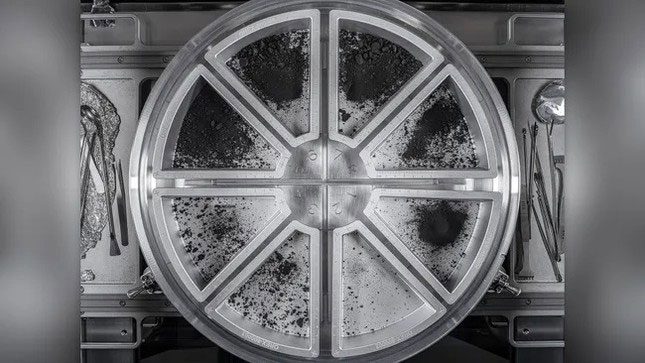The final tally from NASA indicates that the OSIRIS-REx spacecraft has collected approximately 120 grams of material from the asteroid Bennu. The samples collected from this “potentially hazardous” asteroid are believed to contain some of the earliest signs of life.
NASA scientists have finally counted the amount of material obtained by the spacecraft from a distant “potentially hazardous” asteroid, which is more than double what they initially expected.

Close-up of NASA’s OSIRIS-REx sample trays, containing dust and debris collected from the asteroid Bennu. (Photo: NASA/Erika Blumenfeld & Joseph Aebersold).
This sample – weighing approximately 122 grams of space debris collected by the OSIRIS-REx spacecraft from the asteroid Bennu – may contain some of the earliest precursors to life and is the first asteroid material recovered by a NASA mission.
After landing in the Utah desert on September 24, 2023, the OSIRIS-REx spacecraft was transported to NASA’s Johnson Space Center in Houston, where scientists began the challenging task of dismantling it, which proved to be much more difficult than many had anticipated. Two of the spacecraft’s 35 latches were stuck, causing NASA researchers to initially collect only about 70.3 grams of samples located on the lid of the container.
Subsequently, after designing and testing specialized tools, the scientists were finally able to open the last two latches. Once fully disassembled, they collected an additional 51.2 grams of material from inside.
The NASA mission began in September 2016 and traveled 320 million kilometers to reach Bennu before returning to Earth with the samples in May 2021. The scientists of the OSIRIS-REx mission spent nearly two years searching for a landing site on the treacherous surface of the asteroid Bennu. Upon contact with this asteroid, OSIRIS-REx shot a burst of nitrogen from the Touch-and-Go Sample Acquisition Mechanism to secure its position and prevent the spacecraft from sinking while collecting samples.
NASA’s spacecraft brought back highly anticipated materials, including rocks approximately 4.5 billion years old from the early solar system. These materials also contain some primordial elements believed to have sparked life on Earth.
Recently, similar rocks, such as uracil, have been discovered on the asteroid Ryugu by the Japan Aerospace Exploration Agency’s Hayabusa2 spacecraft, which returned to Earth with rock samples in 2020. Scientists from the OSIRIS-REx mission are hopeful to find such biological precursors in the samples returned from the asteroid Bennu.


















































